| Content |
Ray Flash ring flash adapter is a flash light modifier that turns your flash gun into a ring flash. It is intended to be used with a flash mounted on camera. Ray Flash simply slides onto a flash head. The flash light passes through the internal "light channels" of the adapter and reflects around the camera lens. This creates a unique look specific to ring flashes often used in fashion photography.
Since Ray Flash is merely a reflector, it does not emit light by itself. And changing the quality of light always comes at a price of light loss and reduced shooting range. The design of Ray Flash is quite complex, however, and it does an impressive job of loosing just one stop of light.
Another great benefit of being an adapter to a modern flash is to be able to work with TTL systems. As many other flash light modifiers, Ray Flash does not affect the TTL metering, so users can enjoy the convenience of the modern technologies.
Also, it's worth mentioning that Ray Flash is color neutral and does not changes white balance.
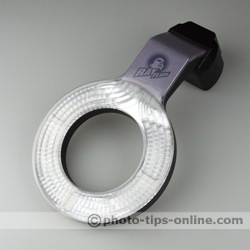 |
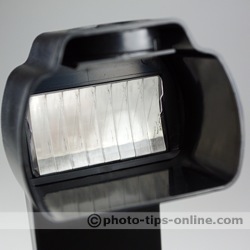 |
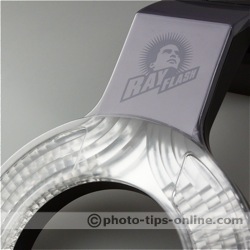 |
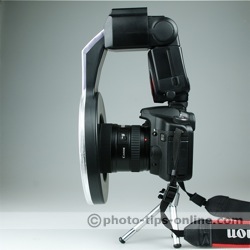 |
Ray Flash adapters are made to fit a particular flash gun as well as a particular camera body. At the moment, ExpoImaging offers 10 different flavors of this light modifier. Our version is made to fit Canon 580EX II flash and Canon 50D camera body (it also fits similarly sized 40D, 30D, etc.).
The quality of Ray Flash appears to be very good. It should be able to withstand normal wear and a reasonable amount of workload.
The body is all-plastic and, therefore, lightweight. (The unit weights around a pound.) It is slim and portable (compared to ring flashes). It should not be a problem to carry it around in a gear bag.
Attaching Ray Flash to a flash is a breeze. The adapter features a lock to prevent the adapter from sliding off. Since Canon 580EX II flash head has rubber sides, our version of Ray Flash fits quite snugly, and the locking is not even necessary. But, of course, it's better to always use the lock for your own peace of mind.
For the best results, the ring flash has to be perpendicular to the lens axis. With Ray Flash adapter, this may not be the case depending on the design of the flash it's used with. To address this issue, two wedges are included with the product to be used to improve the alignment. With our Canon 580EX II, the adapter is not perfectly aligned with the lens plane, but we decided not to use the wedges since it's not that critical in our case.
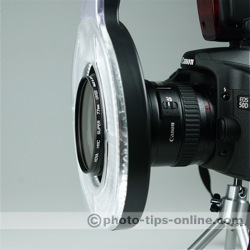 |
As you can from in the images below, Ray Flash is very well centered when shooting in landscape camera orientation.
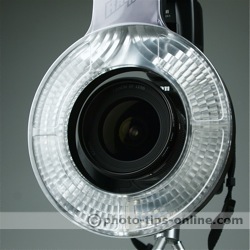 |
Due to some wobbliness of many flash heads, Ray Flash can get off center when shooting in the portrait mode. If you want to avoid that, it might be a good idea to hold the adapter with the same hand you hold the lens, while taking a shot. This lets you center the lens within the ring and reduce the stress on the flash head.
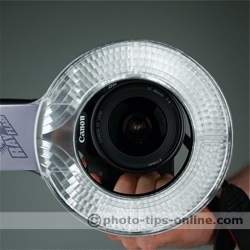 |
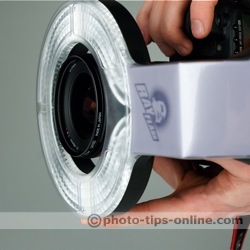 |
We have to mention that even though Ray Flash does a great job in distributing light around the lens, the light is not completely even. The image below shows that the side closer to the flash head emits more light than the opposite side.
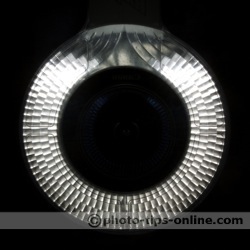 |
Ray Flash works great for macro photography. It can be also useful in food and product photography (on its own or as a part of multi-light setup). Below is a couple of examples where the adapter was used as the only source of light.
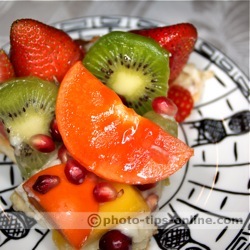 |
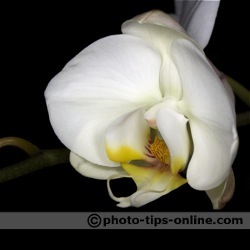 |
When shooting portraits, Ray Flash, like other ring lights, produces images with practically no shadows on model's face. Shadows on the background follow the contour of the subject, which is another reason why ring flashes are often used for.
Ring lights produce a unique ring-shaped catchlight in the eyes of the subject. This type of catchlight can be very appealing to some people while others find it unnatural and try to avoid it. The following three images are headshots taken with Ray Flash as the only source of light. The camera was position from 2 to 4 feet from the subject.
 |
 |
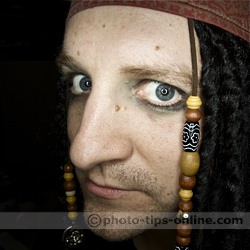 |
Ray Flash ring flash adapter is an exciting tool that gives you a unique look in portraits, works great as a shadowless fill light, and can be useful in macro and tabletop photography. It is less expensive (currently around $200) than most of the ring flashes on the market. So, if you don't need a ring flash as a main photographing tool, Ray Flash can be worth a try. It gives you all the benefits of the ring type of light without investing too much money.